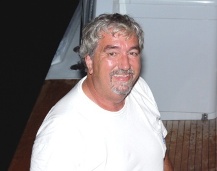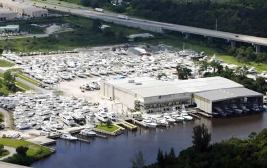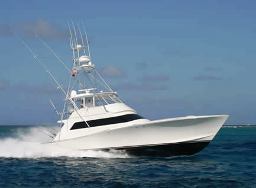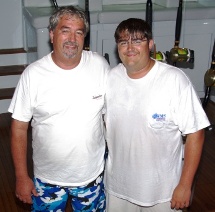 “I’m a speed freak,” admits Dominick LaCombe, an avid angler and owner of American Custom Yachts, based in Stuart, Florida. “People ask me when I’m going to build a ‘green’ boat, but I’ve always gone for efficiency and getting the most out of the horsepower.”
“I’m a speed freak,” admits Dominick LaCombe, an avid angler and owner of American Custom Yachts, based in Stuart, Florida. “People ask me when I’m going to build a ‘green’ boat, but I’ve always gone for efficiency and getting the most out of the horsepower.”
Born and raised in Vineland, New Jersey, LaCombe began fishing at the age of 9. He’d angled with his grandfather, who had a Navy, Coast Guard and Merchant Marine background, aboard the elder’s 30-foot fishing boat. “We’d troll for tuna and marlin off the coast,” he says.
LaCombe recognized right out of high school that he loved fishing and more importantly was also mechanically inclined. These two talents led him to the helm of a 45-foot Hatteras, the R-T, where at the age of 19 and from the mid- to late-70s he captained for a private owner. The R-T was based in Cape May, but LaCombe and his owner traveled to many tournaments from New York to Mexico each year.
“I remember fishing one year in the Stone Harbor Invitational,” he recalls. “We fought a swordfish for 11 hours, a 500-pound-plus fish on 50-test, and backed down 38 miles before we lost it. That was a story! We did win the Hard Luck award.”
Another memory, LaCombe recalls, is winter fishing for cod off Barnegat Bay. “It was so cold that the grape juice separated from the alcohol in the wine and froze. I definitely like fishing where it’s warmer.”
In the early 80s, LaCombe left the R-T when he was asked to help build a 63-footer called the Glass Machine for Monterey Marine in Stuart. After that, he then became one of the yard crew, building vessels that ran at top speeds.
 “This was the era that ushered in fast boats. Jim Smith and Monterey were the pioneers in speed,” LaCombe explains. “For example, I went from 18 knots on the Hatteras 45 to going 41 mph on the Glass Machine. It was revolutionary. Akin to trolling with baits, then lures and now pitch-baiting.”
“This was the era that ushered in fast boats. Jim Smith and Monterey were the pioneers in speed,” LaCombe explains. “For example, I went from 18 knots on the Hatteras 45 to going 41 mph on the Glass Machine. It was revolutionary. Akin to trolling with baits, then lures and now pitch-baiting.”
He adds, “It’s not speed for speed’s sake, but to allow more time for fishing. The fishing grounds off New Jersey, for example, are 60 to 90 miles offshore. It’s the difference of leaving just after midnight or at daybreak. There’s also a satisfaction in being back at the dock with the boat all washed down just when the other boats are just pulling in.”
Hull construction is a key element of speed. It also impacts ride.
“Fiberglass is heavy,” says LaCombe. “We started using Kevlar with the Glass Machine. That’s what got it nicknamed the Kevlar rocket.”
LaCombe’s career at Monterey skyrocketed as fast as the boats he was building.
“I was vice president and running the company at the age of 29,” LaCombe says.

 Less than a decade later, in 1992, he went out on his own and teamed up with the Chouest Family as partners to form American Custom Yachts (ACY). A few years later, LaCombe bought Monterey and he’s been based and building boats like Freedom, Que Mas and Black Gold (photo right) in Stuart ever since.
Less than a decade later, in 1992, he went out on his own and teamed up with the Chouest Family as partners to form American Custom Yachts (ACY). A few years later, LaCombe bought Monterey and he’s been based and building boats like Freedom, Que Mas and Black Gold (photo right) in Stuart ever since.
His position as a boat builder allowed LaCombe to fish with a variety of people and in a variety of places, including making transatlantic and transcanal voyages to the Pacific.
“I remember we caught 7 white marlin, 1 swordfish and 11 yellowfin in one day in a tournament off Bayshore, New York,” he says.
Billfish are his favorite specie to catch.
“I like the bite and the jump,” he says. “It’s like going to the movies. The best part is watching the show.”
 Just as LaCombe’s family all works together at ACY, so do they all enjoy fishing together. In fact, earlier this year he had his 18-month old grandson out on the boat while swordfishing off Palm Beach.”
Just as LaCombe’s family all works together at ACY, so do they all enjoy fishing together. In fact, earlier this year he had his 18-month old grandson out on the boat while swordfishing off Palm Beach.”
“All my kids have caught a marlin. In fact, my daughter caught her first blue marlin in St. Thomas.”
St. Thomas does hold special memories for LaCombe and it’s a destination he fishes often.
“We won the Race from the Edge in the Boy Scout Tournament (USVI Open/Atlantic Blue Marlin Tournament) the first year we brought Freedom down. That was 1993 or 1994,” he says. “Ironically, the second place boat was a Monterey. I built them both.”
LaCombe’s current project, one that’s projected at 2 ½-years from start to finish, is building the world’s fastest sports fishing boat.
“We went from building the 80-foot Patriot in 1989 that goes 48 knots with 7000 HP engines to now building a 90-footer with 9200 HP engines that we think will go over 50 knots,” he says.
Not many people get up everyday and look forward to going to work.
“But I do,” says LaCombe. “Though, I would like to get to the point where if I wake up and it’s blowing I’ll go hunting and if its calm I’ll go fishing.”
